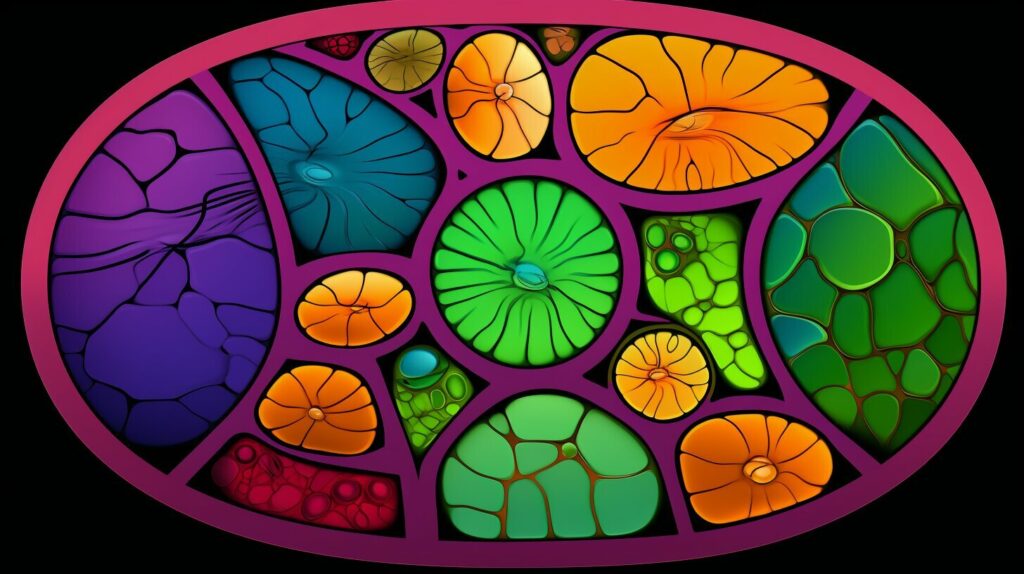I often find myself researching complex topics to provide valuable information to readers. Today, we will discuss the cellular structure of plants and answer a fundamental question – are plants unicellular or multicellular?
Plant classification is based on their cellular composition, and it is essential to understand this concept before proceeding further into the topic. Let’s dig into the details to unveil the truth about plants.
- Plant classification is based on their cellular composition.
- We will explore the cellular structure of plants and answer the question of whether they are unicellular or multicellular.
- Understanding plant cells’ different types and functions will help us appreciate the complexity and importance of plant life.
Types of Plant Cells and Their Functions
Plant cells are the building blocks of all plants, and their structure and functions are critical to the growth and development of plants. There are several types of plant cells, each with its unique characteristics and functions.
The basic structure of a plant cell consists of a cell wall, cell membrane, cytoplasm, and organelles such as the nucleus, mitochondria, and chloroplasts. The cell wall provides structural support and protection, while the cell membrane controls the movement of substances in and out of the cell.
The different types of plant cells include parenchyma cells, collenchyma cells, and sclerenchyma cells, which are responsible for providing support and structure to different parts of the plant. Parenchyma cells are found in the leaves, stem, and roots of plants and are responsible for photosynthesis and storage of nutrients. Collenchyma cells are also found in the stem and leaves and provide mechanical support to the growing plant. Sclerenchyma cells are found in the stems and leaves of plants and provide structural support to the plant.
There are also specialized plant cells, such as xylem and phloem, which are responsible for transporting water and nutrients throughout the plant. Xylem cells are long and tubular, and they carry water and dissolved minerals from the roots to the leaves. Phloem cells are also tubular and carry organic compounds, such as sugars, from the leaves to the rest of the plant.
Overall, the functions of plant cells are diverse and complex. They play a critical role in photosynthesis, respiration, nutrient transport, and reproduction of plants. Understanding the different types of plant cells and their functions is essential to appreciate the complexity and importance of plant life.

It is fascinating to note that the structure and functions of plant cells have inspired many innovations in technology and medicine. For example, scientists have developed biofuels from plant cell walls, and researchers are studying the use of plant cells to produce new drugs to fight diseases.
In the next section, we will take a closer look at unicellular plants and their significance in the world of biology.
Unicellular Plants: A Closer Look
While most plants are multicellular, there are also some unicellular plants that play crucial roles in various ecosystems. Examples of unicellular plants include algae and bacteria.
Despite their small size, unicellular plants have significant importance in the environment. They are primary producers, responsible for producing a large proportion of the world’s oxygen through the process of photosynthesis. Unicellular plants also contribute to nutrient cycling and the food web, serving as a food source for other organisms.
The importance of plant cells cannot be overstated. Plant cells are responsible for carrying out essential functions such as photosynthesis, nutrient transport, and reproduction. They are also important in providing structural support for the plant.
Without plant cells, the survival of a plant would be impossible. The different types of plant cells have specific functions, such as parenchyma cells for storage and collenchyma cells for support. Specialized plant cells like xylem and phloem transport water and nutrients throughout the plant, allowing it to grow and survive in changing environments.

“The importance of unicellular plants in the environment cannot be overstated. They serve as primary producers and contribute to nutrient cycling and the food web, making them essential to the survival of many organisms.”
Overall, while most plants are multicellular, unicellular plants play crucial roles in various ecosystems. Understanding the importance of plant cells, both unicellular and multicellular, is key to appreciating the complexity and significance of plant life.
Multicellular Plants: Structure and Organization
Multicellular plants have a complex structure that is composed of different tissues and organs. These tissues and organs work together to provide the plant with support, food, and water. The plant cell structure is a crucial factor in the growth and organization of multicellular plants.
The four main tissue types that make up multicellular plants are:
- Epidermis: The outermost layer of cells that protect the plant from external factors such as water loss and disease.
- Ground tissue: The bulk of the plant, responsible for photosynthesis, storage, and support.
- Vascular tissue: Consists of xylem and phloem which transport water and nutrients throughout the plant.
- Meristematic tissue: Composed of actively dividing cells that contribute to the growth of the plant.
The structure of multicellular plants is organized hierarchically with organs such as leaves, stems, and roots. Leaves are the primary organs of photosynthesis in plants, stems provide support for the plant and transport nutrients, while roots anchor the plant to the ground and absorb water and nutrients from the soil.
An important aspect of the organization of multicellular plant structure is the role of plant cells in supporting their growth and development. Plant cells undergo a process called cell elongation, where they expand in size and push against each other to create a rigid structure. This structure enables the plant to grow taller and support its own weight.

The plant cell structure and organization are critical to the survival and growth of multicellular plants. Understanding the different tissue types and the role of cells in their development provides insight into the complexity of plant life.
The Significance of Plant Cells
Plant cells play a vital role in the survival and functioning of plants. Their functions are diverse, ranging from photosynthesis to nutrient transport and reproduction. Let’s take a closer look at the importance of plant cells in these processes.
One of the primary functions of plant cells is photosynthesis, the process by which plants convert sunlight into energy. Chloroplasts, the organelles responsible for this process, are found in plant cells. Chloroplasts contain chlorophyll, which absorbs light energy and uses it to produce glucose, a type of sugar that serves as the primary energy source for plants.
Plant cells are also responsible for the transport of nutrients throughout the plant. Xylem and phloem, specialized plant cells, are responsible for the transportation of water, minerals, and other nutrients throughout the plant’s tissues. Xylem transports water and minerals from the roots to the leaves, while phloem transports glucose and other nutrients from the leaves to the rest of the plant.
In addition to these functions, plant cells also play a crucial role in reproduction. Gametes, the reproductive cells in plants, are also found in plant cells. These cells combine during fertilization to form a zygote, which develops into a new plant.
In summary, plant cells are essential to the survival and functioning of plants. They are responsible for photosynthesis, nutrient transport, and reproduction, all of which contribute to the growth and development of plants. Understanding the functions of plant cells helps us appreciate the complexity and importance of plant life.

As we’ve explored in this article, plant cells are essential to the survival and functioning of plants. They play critical roles in processes like photosynthesis, nutrient transport, and reproduction. Each type of plant cell has a specific function that contributes to the growth and development of the plant.
Understanding the different types of plant cells and their functions is crucial to appreciating the complexity of plant life. From parenchyma cells to specialized cells like xylem and phloem, each type of cell has a specific function that contributes to the overall health and vitality of the plant.
Furthermore, the classification of plants is based on their cellular composition. Knowing whether a plant is unicellular or multicellular is key to understanding its properties and behaviors. Unicellular plants, like algae and bacteria, play vital roles in ecosystems and serve as important sources of food and oxygen.
Ultimately, the significance of plant cells cannot be overstated. They are the building blocks of plant life, and without them, the world as we know it would be fundamentally different.
Conclusion
In conclusion, we have discovered that plant cells are critical to the survival and functioning of plants. Understanding the different types of plant cells and their functions helps us appreciate the complexity and importance of plant life. Whether a plant is unicellular or multicellular, its cells are key to its growth, development, and overall health.
By gaining a deeper understanding of plant cells and their significance, we can better appreciate the beauty and diversity of the plant world.
FAQ
Q: Are plants unicellular or multicellular?
A: Plants are primarily multicellular organisms. However, there are also unicellular plants, such as algae and bacteria, that play important roles in ecosystems.
Q: What are the types of plant cells and their functions?
A: The different types of plant cells include parenchyma cells, collenchyma cells, sclerenchyma cells, xylem, and phloem. Each type has specific functions, such as providing structural support, conducting water and nutrients, and photosynthesis.
Q: What are unicellular plants and why are they important?
A: Unicellular plants, such as algae and bacteria, are composed of a single cell. They are important for various ecological processes, including oxygen production, nutrient cycling, and serving as primary producers in aquatic ecosystems.
Q: How are multicellular plants structured and organized?
A: Multicellular plants have complex structures and are organized into tissues and organs. Different tissues, such as the epidermis, mesophyll, and vascular tissue, perform specific functions in supporting growth, reproduction, and nutrient transport.
Q: What is the significance of plant cells?
A: Plant cells play crucial roles in processes like photosynthesis, nutrient transport, and reproduction. They contribute to the overall survival and functioning of plants, enabling them to grow, reproduce, and interact with their environment.
Q: Are plants classified based on their cellular composition?
A: Plant classification is based on various factors, including cellular composition. However, it also takes into account other characteristics such as morphology, reproductive mechanisms, and genetic relationships.





Pingback: Exploring Reality: Can Plants Feel Pain?